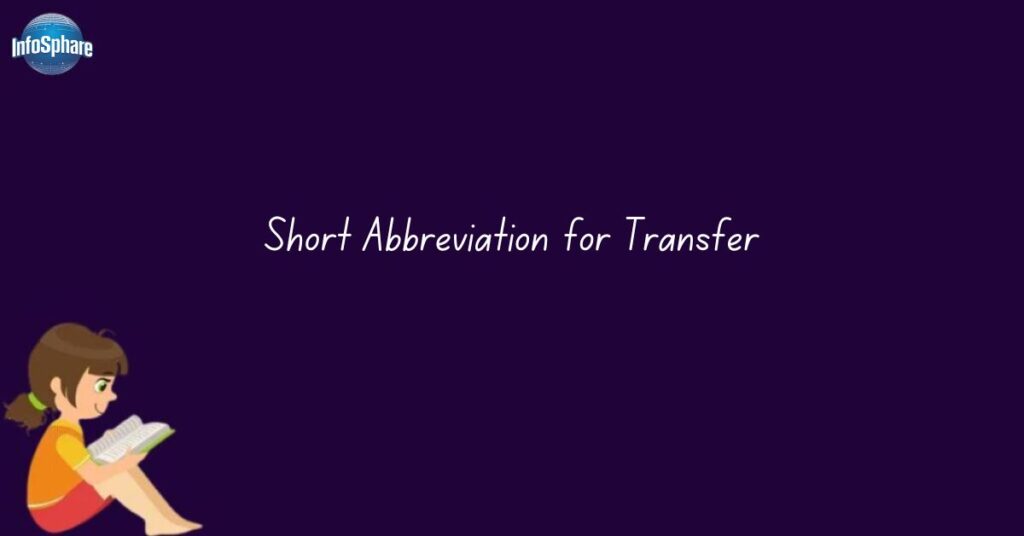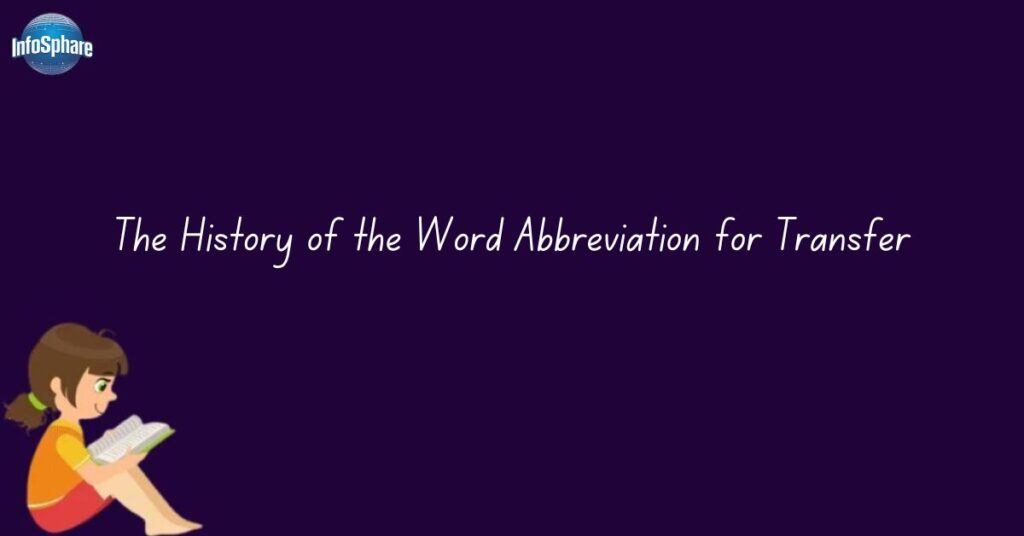The abbreviation for transfer is “TRANSF.” It is commonly used to shorten the word, especially in professional settings. This helps save time and space in communication.
Have you ever wondered how abbreviations can make your work easier? Using “TRANSF” can simplify your writing, especially in busy environments. It’s quick, clear, and effective.
“TRANSF” is used across various fields like finance and logistics. It’s pronounced /træns-fər/ and helps streamline communication. Examples include “Please confirm the TRANSF of funds” or “The TRANSF will be finalized soon.”
What is the Abbreviation for Transfer?
The abbreviation for transfer is TRANSF. It’s a short way to write the full word especially in busy work environments. People use TRANSF in places like finance logistics and education to save time and make communication faster.
Using TRANSF can help you avoid writing the full word again and again. It’s helpful in emails forms and reports where you need to be quick. For example in finance you might say Please confirm the TRANSF of funds instead of writing transfer each time.
The pronunciation of transfer is /træns-fər/. Saying it this way can help you use it correctly in conversations. So whether you’re talking about a money transfer student transfer or moving goods in logistics TRANSF makes things simple and clear.
What Does Abbreviation for Transfer Mean?

The abbreviation for transfer means a shorter way to write the word transfer. It is used to save time and space in communication. TRANSF is commonly used in finance, logistics, and education to make messages faster and clearer.
In finance, it often refers to moving money from one account to another. In logistics, it can mean moving goods from one place to another. In education, it refers to moving a student from one school to another.
Using TRANSF instead of writing the full word transfer helps to keep things simple. It is especially helpful when you’re dealing with a lot of information or need to write quickly.
Understanding the Term “Transfer”: Definition and Pronunciation
The term transfer means moving something from one place to another. It can be about moving money between accounts, sending goods from one location to another, or shifting a student from one school to another. Essentially, it’s about changing the position or ownership of something.
The pronunciation of transfer is /træns-fər/. It is said in two parts: “trans” and “fer.” In casual speech, the “r” sound may be softer or even dropped, especially in American English.
Understanding transfer helps you use it properly in different situations like finance, logistics, and education. Whether it’s moving money, goods, or people, knowing the meaning and pronunciation makes communication clearer.
Why Use the Abbreviation for TRANSF?
Using the abbreviation TRANSF helps save time and space in communication. It’s especially useful when you need to write quickly or keep messages short. In fast-paced work environments like finance, logistics, and education, TRANSF makes things more efficient.
For example, instead of repeatedly writing transfer, you can simply write TRANSF to convey the same meaning. This makes emails, reports, and notes quicker to read and easier to understand, especially when dealing with a lot of transactions or information.
By using TRANSF, you avoid repeating long words and keep communication clear and concise. This can be helpful in any field where speed and accuracy are important.
Real-Life Examples: How “Transfer” and “TRANSF” Are Used
In real-life situations, both transfer and its abbreviation TRANSF are used in different ways depending on the industry. In finance, you might hear: “The transfer of funds was completed successfully” or in a shorter form, “Please confirm the TRANSF of funds by the end of the day.”
In finance, the full term might be: “The transfer of funds from one account to another was completed successfully.” A shorter way to write it could be: “Please confirm the TRANSF of funds by the end of the business day.”
In education, you could see the full term: “The transfer of the student from one school to another was approved by the board.” A quicker version would be: “The TRANSF process will be finalized before the start of the semester.”
In logistics, the full sentence might be: “The transfer of goods from the warehouse to the retail store is scheduled for next week.” Instead, you could write: “Please complete the TRANSF of the inventory to the new location.” These examples show how TRANSF is a simple way to communicate effectively and save time.
Short Abbreviation for Transfer

The short abbreviation for transfer is TRANSF. It is widely used across various industries such as finance, logistics, and education to make communication quicker and more efficient. By using TRANSF, you avoid repeating the full word transfer, making your writing shorter and easier to read.
In professional settings, especially when time is of the essence, TRANSF helps streamline communication. Whether you’re dealing with financial transactions, moving goods in logistics, or managing student transfers in education, using this abbreviation saves space and speeds up the process.
Related Acronyms: Broader Context of “Transfer”
There are several related acronyms that help explain different types of transfer in specialized contexts. One of these is FTP, which stands for File Transfer Protocol. FTP is a standard network protocol used to transfer files between computers over the internet or a local network. It is commonly used for uploading and downloading files from servers, particularly in web development and digital file management.
Another important acronym is SWIFT, which stands for Society for Worldwide Interbank Financial Telecommunication. SWIFT is a global network used by banks and other financial institutions to send secure and standardized financial messages. This system plays a crucial role in international money transfers, enabling fast and reliable communication between financial entities worldwide.
In logistics, the term transfer can also relate to the movement of goods or products from one location to another. While TRANSF is a shorthand for transfer, there are other specialized terms used in supply chain management, such as TMS (Transportation Management System), which helps streamline the transfer of goods efficiently across multiple transport modes.
In addition, acronyms like MT for Money Transfer are also commonly used in the finance industry. MT refers to the process of transferring money between accounts, often across borders, for individuals or businesses. These related acronyms show how transfer is used in different industries, enhancing communication and efficiency in each sector.
Also Read this: CNC Meaning: Internet Urban Slang
How to Pronounce Abbreviation for Transfer

The pronunciation of the abbreviation TRANSF is quite similar to the full word transfer. It’s typically pronounced as /træns-f/. The “r” sound in transfer is often softened or even dropped in TRANSF, especially in casual speech.
When saying TRANSF, break it down into two parts: trans and f. Start with trans as you would in the full word, and then say the f sound clearly at the end. It’s a simple and quick pronunciation that makes it easy to use in fast-paced communication.
Other Examples
You may also come across other relevant abbreviations related to transfer, such as MT for Money Transfer. This is commonly used in finance and banking when referring to the process of moving money from one account to another, especially across borders.
- MT: Stands for Money Transfer, commonly used in finance and banking for transferring money between accounts, especially across borders.
- SWIFT: Refers to Society for Worldwide Interbank Financial Telecommunication, a global network enabling secure transfer of financial messages between banks.
- FTP: Short for File Transfer Protocol, used in technology for transferring files over the internet.
Synonyms for Transfer
Here are some synonyms for transfer:
- Move: Often used for physically shifting items or people.
- Shift: Used for changing positions or direction, especially in abstract contexts.
- Relocate: Typically refers to moving a person or organization to a new place.
- Transport: Focuses on moving goods or people from one location to another.
- Transmit: Commonly used for transferring information or signals.
- Convey: Refers to moving something from one place to another, often in a formal sense.
Antonym for Transfer
Here are some antonyms for transfer:
- Retain: To keep something in its current place or state.
- Hold: To keep something in one’s possession without moving it.
- Keep: Similar to retain, meaning to not move or give something away.
- Store: To place something in a designated location for future use without transferring it elsewhere.
The History of the Word Abbreviation for Transfer

The word transfer has its roots in the Latin language. It is derived from the word transferre, which is a combination of two parts: trans meaning across and ferre meaning to carry. The term originally referred to the act of carrying something across a boundary or from one place to another.
This definition clearly emphasizes the movement or shifting of an object, person, or idea from one location to another, whether it’s physical or metaphorical.
Historically, transfer was most commonly used in legal contexts, particularly to describe the formal process of transferring ownership of property, such as land or assets. The process was seen as a legal contract where the rights of possession were moved from one party to another.
Over time, the word evolved to cover a broader range of uses beyond legal documents. It began to describe actions like transferring money between accounts, moving people from one location to another, or shifting goods in the logistics and supply chain industries.
As transfer gained popularity, especially with advancements in business, finance, and communication, it found its way into various industries, each adapting the concept to their specific needs. In finance, it refers to the movement of funds between accounts, while in education, it involves students moving from one school to another.
In technology, it can refer to the process of sending data from one device or server to another. This versatility in usage has made the word transfer an essential term in both everyday language and specialized fields.
The abbreviation for transfer, TRANSF, began to be used as a shorthand in industries where efficiency and speed are crucial, such as finance, logistics, and education. The need for quick communication led to the adoption of TRANSF in forms, reports, and transactions, making it easier to convey the concept without taking up too much space or time.
Over the years, transfer has adapted to meet the demands of modern communication while still holding onto its foundational meaning of moving something from one point to another.
When to Use the Abbreviation for TRANSF
The abbreviation TRANSF is helpful in various situations where space and time are limited, especially in fast-paced work environments. It’s commonly used in finance, logistics, and education when a large volume of transactions or data needs to be conveyed quickly. For instance, if you are sending a report or an email about financial transactions, using
TRANSF helps streamline communication without sacrificing clarity. It’s especially effective in documents like bank statements, invoices, or spreadsheets where brevity is crucial.
However, it’s important to know when TRANSF is appropriate and when the full word transfer should be used. In formal documents, especially those where precision is key, it’s a good practice to write out transfer at least once to ensure all readers understand the context.
After that, you can use TRANSF as a shorthand to make communication more efficient. For example, in a legal document or an official report, you might first mention the full term, and then use the abbreviation for subsequent references. This ensures clarity and professionalism in your writing.
Example of the Word and Abbreviation in Context
Here’s how to use the abbreviation TRANSF in different contexts, with examples:
In formal writing or reports, you should first spell out the full word transfer before using the abbreviation TRANSF. This ensures that everyone understands the meaning.
Example:
Full term: “The transfer of assets from one account to another was completed successfully.”
Abbreviation: “The TRANSF will be reflected in the quarterly report.”
In more casual settings or when space is limited, such as in emails or notes, you can use TRANSF right away after the first mention of the full term.
Example:
Full term: “The transfer of funds between accounts was initiated.”
Abbreviation: “Please confirm the TRANSF before the end of the business day.”
Final Thoughts
In conclusion, the abbreviation TRANSF for transfer is a practical tool that can make communication quicker and more efficient, especially in industries like finance, logistics, and education. By using TRANSF, you save space and time while still conveying important information clearly. However, it’s essential to use it thoughtfully, first introducing the full term to ensure understanding before using the abbreviation in more informal settings.
Whether you’re handling transactions, managing logistics, or discussing student movements, mastering the use of TRANSF can streamline your work and boost your communication efficiency. Just remember to balance clarity and brevity, using the abbreviation where appropriate to maintain professionalism and accuracy in your writing.
Frequently Asked Questions
What is the Abbreviation for Transfer?
The abbreviation for transfer is TRANSF. It is commonly used in finance, logistics, and education to simplify communication.
What Does Transfer Abbreviation Mean?
The transfer abbreviation TRANSF stands for the process of moving something from one place to another. It is used to save time and space in written communication.
How Do You Abbreviate Transfer?
To abbreviate transfer, simply use TRANSF. It helps make documents and notes shorter, especially in fast-paced industries.
What is the Transfer Acronym?
The transfer acronym TRANSF is often used to refer to moving funds, goods, or students. It is a shorthand that is recognized in various sectors.
What is the Transferred Abbreviation?
The transferred abbreviation TRANSF refers to the process of transferring something, such as funds or assets. It keeps communication brief and efficient.
Must Read these magical slangs:
- What is the HYB Meaning in Text and Why It’s So Popular?
- NMMS Meaning in Text: Quick Guide with Examples

Welcome! I’m glad you’re here. My name is Thomas, and this blog is dedicated to English Grammar and more.
I started this blog to share my Grammar site, and it has evolved into a resource where I provide easy and practical tips to help you for better Grammar.



